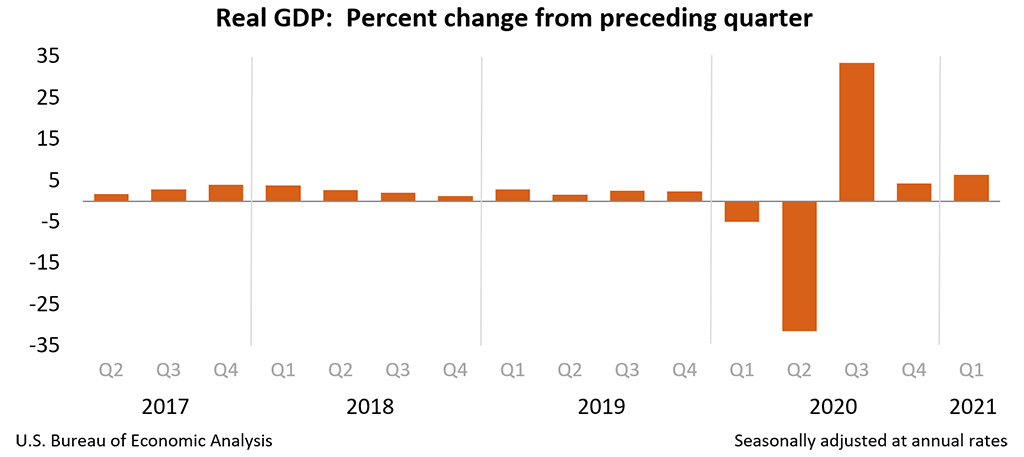Real gross domestic product (GDP) increased at an annual rate of 6.4 percent in the first quarter of 2021 (table 1), according to the “advance” estimate released by the Bureau of Economic Analysis. In the fourth quarter of 2020, real GDP increased 4.3 percent.
The GDP estimate released today is based on source data that are incomplete or subject to further revision by the source agency (see “Source Data for the Advance Estimate” on page 3). The “second” estimate for the first quarter, based on more complete data, will be released on May 27, 2021.
The increase in real GDP in the first quarter reflected increases in personal consumption expenditures (PCE), nonresidential fixed investment, federal government spending, residential fixed investment, and state and local government spending that were partly offset by decreases in private inventory investment and exports. Imports, which are a subtraction in the calculation of GDP, increased (table 2).
The increase in PCE reflected increases in durable goods (led by motor vehicles and parts), nondurable goods (led by food and beverages) and services (led by food services and accommodations). The increase in nonresidential fixed investment reflected increases in equipment (led by information processing equipment) and intellectual property products (led by software). The increase in federal government spending primarily reflected an increase in payments made to banks for processing and administering the Paycheck Protection Program loan applications as well as purchases of COVID-19 vaccines for distribution to the public. The decrease in private inventory investment primarily reflected a decrease in retail trade inventories.
Current‑dollar GDP increased 10.7 percent, or $554.2 billion, in the first quarter to a level of $22.05 trillion. In the fourth quarter, GDP increased 6.3 percent, or $324.5 billion (tables 1 and 3). More information on the source data that underlie the estimates is available in the Key Source and Data Assumptions file on BEA’s website.
The price index for gross domestic purchases increased 3.8 percent in the first quarter, compared with 1.7 percent in the fourth quarter (table 4). The PCE price index increased 3.5 percent, compared with an increase of 1.5 percent. Excluding food and energy prices, the PCE price index increased 2.3 percent, compared with an increase of 1.3 percent.
Personal Income
Current-dollar personal income increased $2.40 trillion in the first quarter, or 59.0 percent, compared with a decrease of $351.4 billion, or 6.9 percent, in the fourth quarter. The increase primarily reflected government social benefits related to pandemic relief programs, notably direct economic impact payments to households established by the Coronavirus Response and Relief Supplemental Appropriations Act and the American Rescue Plan Act (table 8). Additional information on several factors impacting personal income can be found in “Effects of Selected Federal Pandemic Response Programs on Personal Income.”
Disposable personal income increased $2.36 trillion, or 67.0 percent, in the first quarter, compared with a decrease of $402.1 billion, or 8.8 percent, in the fourth quarter. Real disposable personal income increased 61.3 percent, compared with a decrease of 10.1 percent.
Personal saving was $4.12 trillion in the first quarter, compared with $2.25 trillion in the fourth quarter. The personal saving rate—personal saving as a percentage of disposable personal income—was 21.0 percent in the first quarter, compared with 13.0 percent in the fourth quarter.
Source Data for the Advance Estimate
Information on the key source data and assumptions used in the advance estimate is provided in a Technical Note that is posted with the news release on BEA’s website. A detailed Key Source Data and Assumptions file is also posted for each release. For information on updates to GDP, see the “Additional Information” section that follows.


















